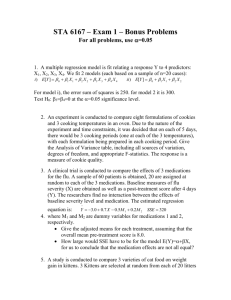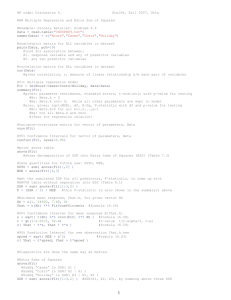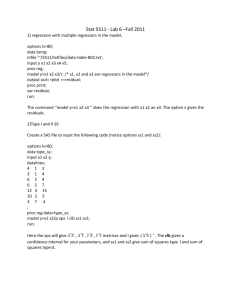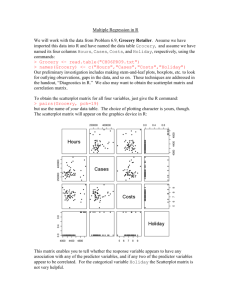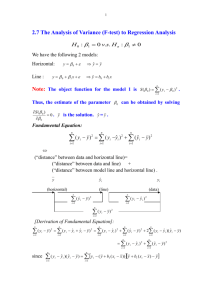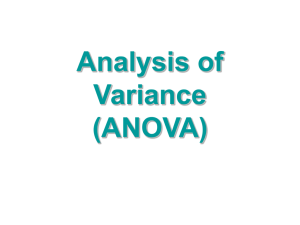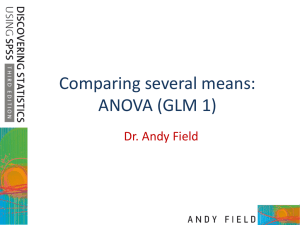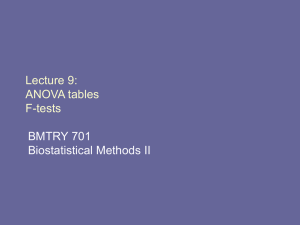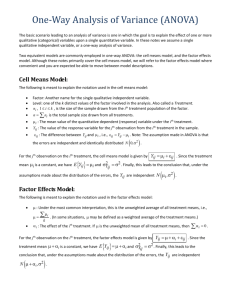Extra Sums of Squares in R
advertisement
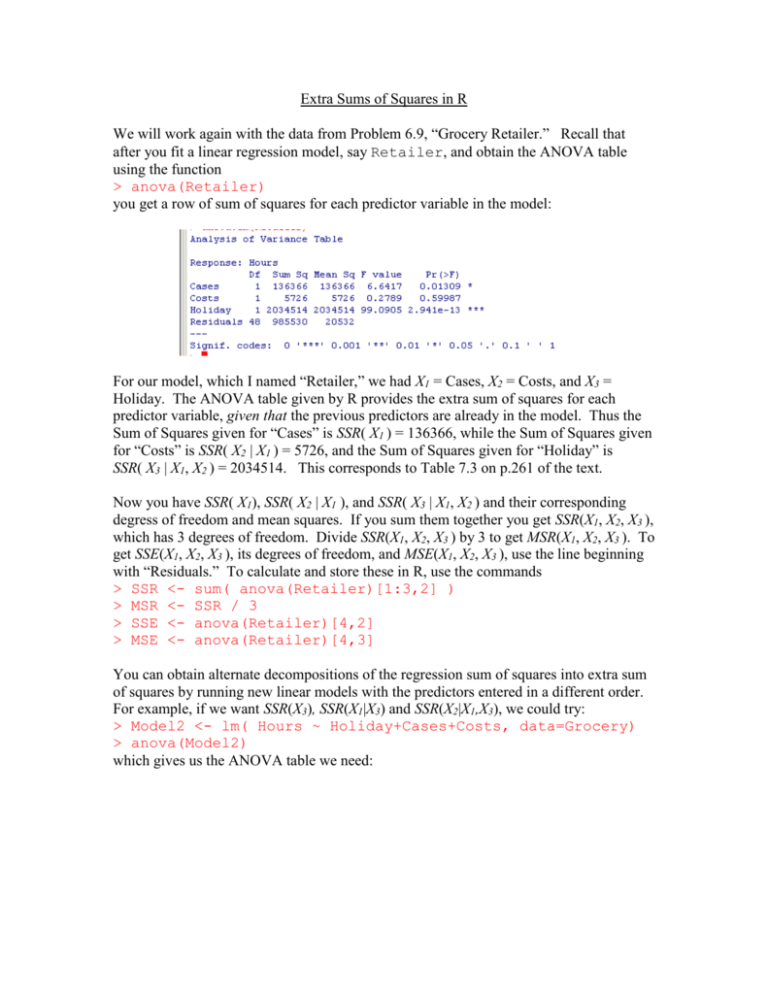
Extra Sums of Squares in R We will work again with the data from Problem 6.9, “Grocery Retailer.” Recall that after you fit a linear regression model, say Retailer, and obtain the ANOVA table using the function > anova(Retailer) you get a row of sum of squares for each predictor variable in the model: For our model, which I named “Retailer,” we had X1 = Cases, X2 = Costs, and X3 = Holiday. The ANOVA table given by R provides the extra sum of squares for each predictor variable, given that the previous predictors are already in the model. Thus the Sum of Squares given for “Cases” is SSR( X1 ) = 136366, while the Sum of Squares given for “Costs” is SSR( X2 | X1 ) = 5726, and the Sum of Squares given for “Holiday” is SSR( X3 | X1, X2 ) = 2034514. This corresponds to Table 7.3 on p.261 of the text. Now you have SSR( X1), SSR( X2 | X1 ), and SSR( X3 | X1, X2 ) and their corresponding degress of freedom and mean squares. If you sum them together you get SSR(X1, X2, X3 ), which has 3 degrees of freedom. Divide SSR(X1, X2, X3 ) by 3 to get MSR(X1, X2, X3 ). To get SSE(X1, X2, X3 ), its degrees of freedom, and MSE(X1, X2, X3 ), use the line beginning with “Residuals.” To calculate and store these in R, use the commands > SSR <- sum( anova(Retailer)[1:3,2] ) > MSR <- SSR / 3 > SSE <- anova(Retailer)[4,2] > MSE <- anova(Retailer)[4,3] You can obtain alternate decompositions of the regression sum of squares into extra sum of squares by running new linear models with the predictors entered in a different order. For example, if we want SSR(X3), SSR(X1|X3) and SSR(X2|X1,X3), we could try: > Model2 <- lm( Hours ~ Holiday+Cases+Costs, data=Grocery) > anova(Model2) which gives us the ANOVA table we need: If you want SSR( X2, X3 | X1 ), for example, use equation (7.4b) on p.260, which gives you SSR( X2, X3 | X1 ) = SSE( X1 ) – SSE( X1, X2, X3 ). This means you will have to run a linear model involving only X1 to obtain SSE( X1 ). Other combinations of error sums of squares can be obtained by fitting reduced models (where you leave out one or two variables), obtaining the values for SSE or SSR, and applying the various formulae given in section 7.1 of the text. Suppose we want to test whether one or more of the variables can be dropped from the original linear model (henceforth called the full model). The easiest way to accomplish this in R is to just run a new model that excludes the variables we are considering dropping (henceforth called the reduced model), then perform a general linear test. For instance, if we are considering dropping Costs ( X2 ) from the Retailer model, we run a reduced model which uses only the other two predictors Cases and Holiday: > Reduced <- lm( Hours ~ Cases + Holiday, data=Grocery) Then to perform the F test, just type > anova(Reduced, Retailer) to get the ANOVA comparison: Note that the first argument to the anova() function must be the reduced model, and the second argument must be the full model (the one with all the original predictors). In this example, we are testing H0: β2 = 0 against H1: β2 ≠ 0, and, since F* = 0.3251 is small, we obtain a very large P-value of 0.5712. So we would not reject H0 at any reasonable level of significance, and thus conclude that the variable Costs can be dropped from the linear model. This agrees with the result of the t-test from the summary table, which had the same P-value, and in fact this value of F* is the square of the value of t* in the summary table. Likewise, this result agrees exactly with the second ANOVA table above. This test statistic may also be obtained using the all-purpose formula given by (2.9) on p.73 of the text. Now suppose we want to test H0: β2 = 0, β3 = 600 against its alternative. In this case the reduced model, corresponding to H0, is Yi = β0 + β1Xi1 + 600Xi3 + i, which may be rewritten as Yi – 600Xi3 = β0 + β1Xi1 + i. To obtain the reduced model in R, use the formulation: > Reduced <- lm(Hours – 600*Holiday ~ Cases, data=Grocery) However, you will get an error message if you attempt to use the anova() function to compare this model with the full model, because the two models do not have the same response variable. Instead, you will need to obtain the SSE for this reduced model, along with its degrees of freedom, from its ANOVA table, and the SSE from the full model, along with its degrees of freedom, from the ANOVA table for the full model, then calculate F* using equation (2.9) in the textbook. To obtain the coefficients of partial determination, you will need to use formulae like those in section 7.4. You may also need to run several different models, with the predictors in various different orders, in order to obtain values for the needed forms of SSE and the extra sums of squares.
